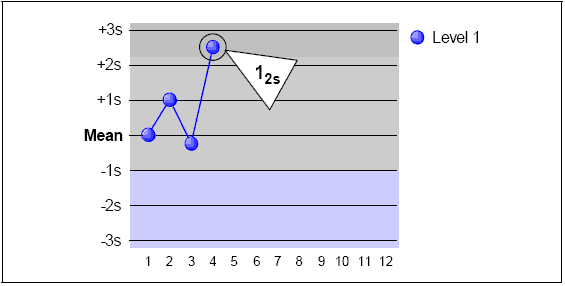The 1-2s rule is usually a warning rule violated when a single control observation is outside the ±2SD limit.
Some laboratories consider any quality control value outside its ±2SD limit to be out of control, and therefore incorrectly decide the patient specimens and QC values are invalid.
An analytical run usually should not be rejected if a single quality control value is outside the ±2SD QC limit but within the ±3SD QC limit. Approximately 4.5% of all valid QC values will fall somewhere between ±2SD and ±3SD limit. Laboratories universally rejecting values outside the ±2SD limit end up rejecting good runs too frequently.
The 1-2s rule was originally designed as a warning rule for manual application of the Westgard rules. If one control measurement within a run exceeds the mean ±2SD in a manual application of Westgard rules, evaluate other controls in the run (within the run) and in previous runs (across runs) before accepting the run and reporting the results. With computer-based applications of Westgard rules, the 1-2s rule is usually not necessary.
Using the 1-2s rule alone in performing quality control tests causes frequent rejection of valid runs. According to Dr. Westgard, failure to allow for valid points between 2SD and 3SD may result in falsely rejecting:
These false rejections result in the unnecessary repeat of patient samples, the waste of labor and materials, and the unnecessary delay of patient results.
The following figure shows a Levey-Jennings Chart with a data point between +2SD and +3SD.

See Also |